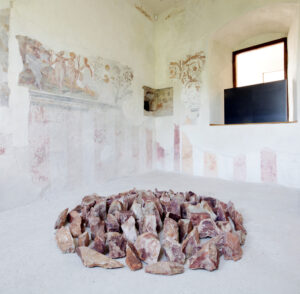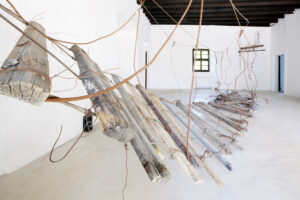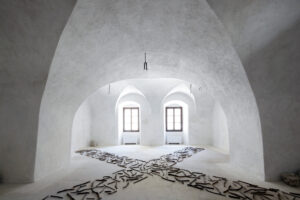It is not easy today to pick up on the thread of that small group of artists – often mistakenly dismissed as a conceptual offshoot of Land Art – who have rethought the artistic experience as a minimal trace, an act of crossing over in the environment. It is not easy to take this search for the existential and primary gesture out of the ways of the art system. Maybe in castles of a valley frequented for other noble reasons, but not for the trajectories of the contemporary. Yet the Urbs Picta association, the Val di Non APT and Panza Collection have found the right place to raise the bar of artistic sensitivity without smoothing out the inevitable interpretative edges in reading the works of Richard Long, Hamish Fulton, Ron Griffin and Daniele Girardi. They have opened public and private manors to make exhibitions one of the many possibilities for reconstructing meanings around the journey, the exploration of space intended as a “place of aesthetic experience”.
The three curators Jessica Bianchera, Pietro Caccia Domeniconi and Gabriele Lorenzoni have chosen as the title of the project A Line Made by Walking, a line designed by Long in ’67 trampling the grass of a field. “Due to its absolute radicalism and formal simplicity, this work is considered a fundamental step in contemporary art: from this moment walking is transformed into an autonomous art form” write the curators. A germinal work that inverts the relationship between the artist and the environment, entrusting the latter with the possibility of leaving traces and triggering the artist to reflect on himself. Precisely where the landscape shows the signs of invasive anthropization (in Val di Non there is not a centimeter free from apple trees), the Belasi, Coredo, Nanno and Valer castles are the opportunity to rethink the beginnings of the relationship between man and the environment. Not places of perpetual dislocation. Precisely where meaning is still suspended between practical function and a symbol of resistance to the useful. No permeating traces among the sticks, Long’s stones but a density of the “here and now” in which the breath of a meditative time is concentrated without objects, without the logistical conditions suited to aesthetics. No White Cube then, but four castles.
The focus of the exhibition is the late thirteenth-century space of Castel Belasi, belonging to the Khuen family. Here a selection of mostly unpublished works by Long, Fulton and Griffin belonging to the Panza Collection are exhibited. Among the 21 works on display at Castel Belasi only 6 have already been exhibited, while 15 are completely unpublished. Among the frescoes and the faces of the castle there is, for example, the hieratic Cross of Sticks by Long and the enigmatic Arziona Circle with its 83 unreachable but terminal stones of a path that includes them as a circular mantra. In Castel Belasi there is also the video installation by the artist Daniele Girardi who documented his journey in the Nordic countries: fatigue and footsteps sinking into the muddy ground of the Mir. His poetics, “in addition to referring to the concept of inaccessibility of the territories explored, testifies to a method of research that is nourished above all by continuous discovery and outdoor life, the result of a long and complex gestation in which the artist absorbs and accumulates experience “.
This is why the two-week residence in Val di Non that produced the Site Specific refuge in Castel Nanno: an archaic residue of waste materials from the sawmill on which the vortex of time has deposited moleskine agendas previously abandoned in nature. Traces of the history that left the scar of the two world wars in this castle.
Castel Valer instead exhibits a focus on Ron Griffin’s research. Inhabited for more than six hundred years by the Counts Spaur of Flavon and Valer, it houses a series of works in the former stables, three of which have been borrowed from the AGIVERONA Collection. Ron Griffin collects remnants of humanity, fragments of stories in the desert vastness of North America. Here, too, the setting revises the living spaces by inserting themselves into everyday life as a possibility of reinterpreting the object.
Castel Coredo instead houses three artist books by Hamish Fulton, Richard Long and Daniele Girardi together with another sculpture by Ron Griffin. The project that inaugurated on June 5 will close on October 30 2021.
Simone Azzoni
Info:
A Line Made by Walking. Immersive practices and experiential residues in Hamish Fulton, Daniele Girardi, Ron Griffin, Richard Long
5.06.2021 – 30.10.2021
Castel Belasi, Campodenno
curated by Jessica Bianchera, Pietro Caccia Dominioni, Gabriele Lorenzoni
in collaboration with Panza Collection
www.urbspicta.org
 A Line Made by Walking. Pratiche immersive e residui esperienziali, installation view, Castel Belasi – Richard Long, Arizona Circle, 1987 – PH credit ©Francesco Mattuzzi, courtesy Panza Collection
A Line Made by Walking. Pratiche immersive e residui esperienziali, installation view, Castel Belasi – Richard Long, Arizona Circle, 1987 – PH credit ©Francesco Mattuzzi, courtesy Panza Collection
 A Line Made by Walking. Pratiche immersive e residui esperienziali, installation view, Castel Belasi – Daniele Girardi, Abaton, 2021 – PH credit ©Francesco Mattuzzi, courtesy Panza Collection
A Line Made by Walking. Pratiche immersive e residui esperienziali, installation view, Castel Belasi – Daniele Girardi, Abaton, 2021 – PH credit ©Francesco Mattuzzi, courtesy Panza Collection
 A Line Made by Walking. Pratiche immersive e residui esperienziali, installation view, Castel Belasi – Richard Long, Cross of Sticks, 1983- PH credit ©Francesco Mattuzzi, courtesy Panza Collection
A Line Made by Walking. Pratiche immersive e residui esperienziali, installation view, Castel Belasi – Richard Long, Cross of Sticks, 1983- PH credit ©Francesco Mattuzzi, courtesy Panza Collection

He is an art critic and professor of Contemporary Art History at IUSVE. He also teaches Critical Image Reading at the Palladio Institute of Design in Verona and Contemporary Art at the Master of Publishing at the University of Verona. He has curated several contemporary art exhibitions in unconventional places. He is the artistic director of the Grenze Photography Festival. He is a theater critic for national magazines and newspapers. He organizes research and experimentation theatrical events. Among the recent publications Frame – Videoarte e dintorni for the University Library, Lo Sguardo della Gallina for Lazy Dog Editions and for Mimemsis Smagliature in 2018 and 2021 for the same publishing house, Theater and photography.






NO COMMENT